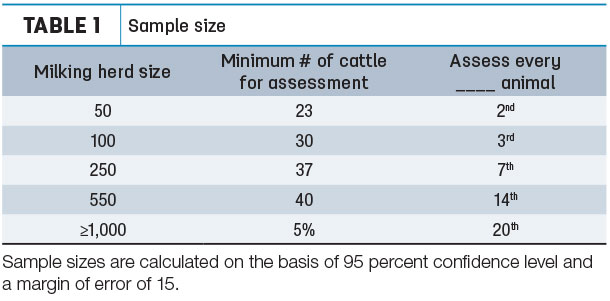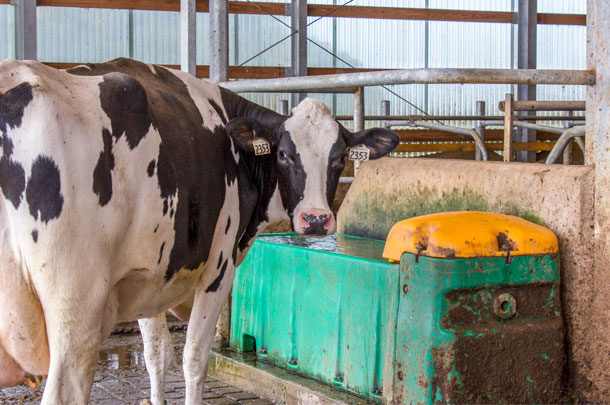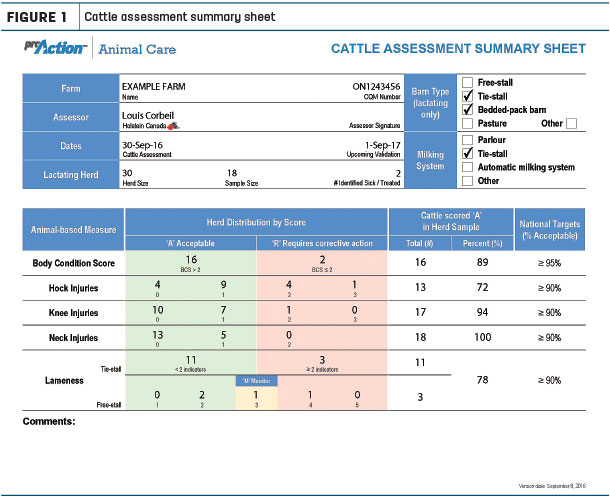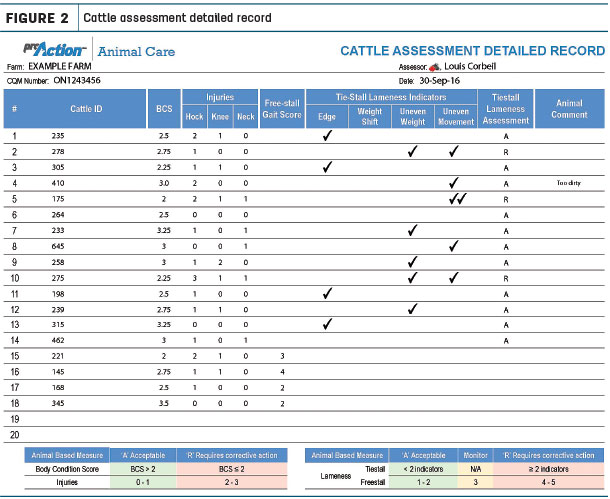Effective Sept. 1, the animal care requirements have been added to the validation process along with the existing food safety requirements (formerly CQM) and livestock traceability requirements (also implemented September 2017).
Alongside the standard operating procedures (SOPs), maintaining records and following best practices, one of the major requirements is cattle assessments. Cattle assessments are conducted on a random sample of the milking herd (currently excluding dry cows); see Table 1. Cattle are assessed for body condition score (BCS), lameness and injuries (hocks, knees and neck). For more information on sample size, please visit the proAction website.

Producers are required to have this independent cattle assessment conducted prior to their official validation date. Currently, these assessments can be completed within a 24-month window prior to validation.
Holstein Canada (HC) was contracted by DFC to be the independent national party to conduct cattle assessments over the two-year contract period. HC classifiers and field staff have been trained and qualified to complete these assessments.
Current process
The provincial milk boards (dairy farmer organizations) have provided HC contact information and validation dates for each producer in their respective provinces. Based on this information, HC prioritizes herds by validation date. Communication packages are mailed to producers 12 to 16 months prior to their validation date. These packages include basic information on animal care and cattle assessments, plus a short survey for producers to fill out and send back to HC. Completing the survey indicates the producer’s intent to complete the cattle assessment.
HC needs this information to “screen” herds into its system. This information is later sent to the assessor who will be conducting the assessment the next time he or she is in the area. The assessor will call the producer one week ahead of time to schedule a time that works best. If you are a classifying herd, the assessment will typically be done on the same visit as classification; please confirm with the classifier when scheduling.
If a producer has not submitted the survey and it is the last opportunity to have the assessment done, as HC will not be back in the area before the herd’s validation date, HC will make one attempt to contact the producer. If there is no response within five business days of the initial call, the producer’s information is sent to the provincial milk board for a follow-up phone call. The provincial milk boards have 12 business days (from the date the list was sent) to contact producers. In the incidence where the milk board receives no response from the producer, the herd is sent back to HC and marked as “declined.” This producer will not have an assessment completed. This may lead to a non-compliance status from the province.
If a herd has been marked as declined and the producer would like to have an assessment completed, there are two options:
Option 1: Pay a re-entry fee of $75, in addition to the assessment fees. This will guarantee the assessment will be completed within the next six months.*
Option 2: Pay a re-entry fee of $1,450, in addition to the assessment fees. This will guarantee the assessment will be completed within the next 21 days.*
*For both options, the producer may also be responsible for any penalties for being non-compliant until the cattle assessment is done.
Cattle assessments
At the time of the assessment, the assessor will confirm with the producer the number of milking cows, which in turn determines the sample size. Cows in a sick pen or identified as receiving additional treatment are excluded. It is best to avoid hoof trimming in the days leading up to the assessment, as cows with blocks or wrapped feet are not excluded. It is also best to avoid strong foot bathing prior to the assessment, as this may impact the lameness assessment.
Assessments will vary based on barn type. For example, if the herd is milking 50 cows, the assessor would assess every other cow. In a tiestall environment, the assessor would first observe the cow for in-stall lameness behaviours, and then assess her BCS and hocks for injuries. The assessor would repeat this process for every other cow. Once the row is complete, the assessor would wash his or her boots off and assess the same cows for knee and neck injuries from the front of the animals.
In a freestall environment with head-locking gates, the assessor would evaluate the cow for BCS and injuries in the headlocks. After releasing her, the assessor would review her gait score for the lameness assessment. If the barn does not have headlocks, the assessor can use the parlour or the barn design (e.g., built-in gates or temporary gates) to systematically assess every other cow. The order in which assessors will collect the measurements may vary, depending on the cows’ positioning.
Once the assessment is complete, a report is generated on the farm. The report will be emailed to the producer or printed if necessary. These reports highlight the herd’s overall assessment as well as how each animal was assessed (see Figures 1 and 2).
Click on the images below to view them in more detail.
Producers will also receive a peer report by email hours after the assessment. It can also be found online in their proAction account. This report benchmarks and compares the individual herd to the national average for each of the measurements. The report also outlines whether or not a corrective action plan is needed.
These three reports and any corrective action plans are required at the time of the herd’s validation.
HC in partnership with DFC and provincial milk boards is available to answer any questions or concerns. Specific questions about cattle assessment can be directed to the HC's proAction line at (855) 756-3500 ext. 275 for service in English and (855) 756-3500 ext. 276 for service in French, or questions can be sent by email. ![]()

-
Jeanette Van der Linden
- Extension and Education Specialist
- Holstein Canada

-
Michelle Linington
- Extension and Education Specialist
- Holstein Canada
PHOTO: Photo by Karen Lee.













